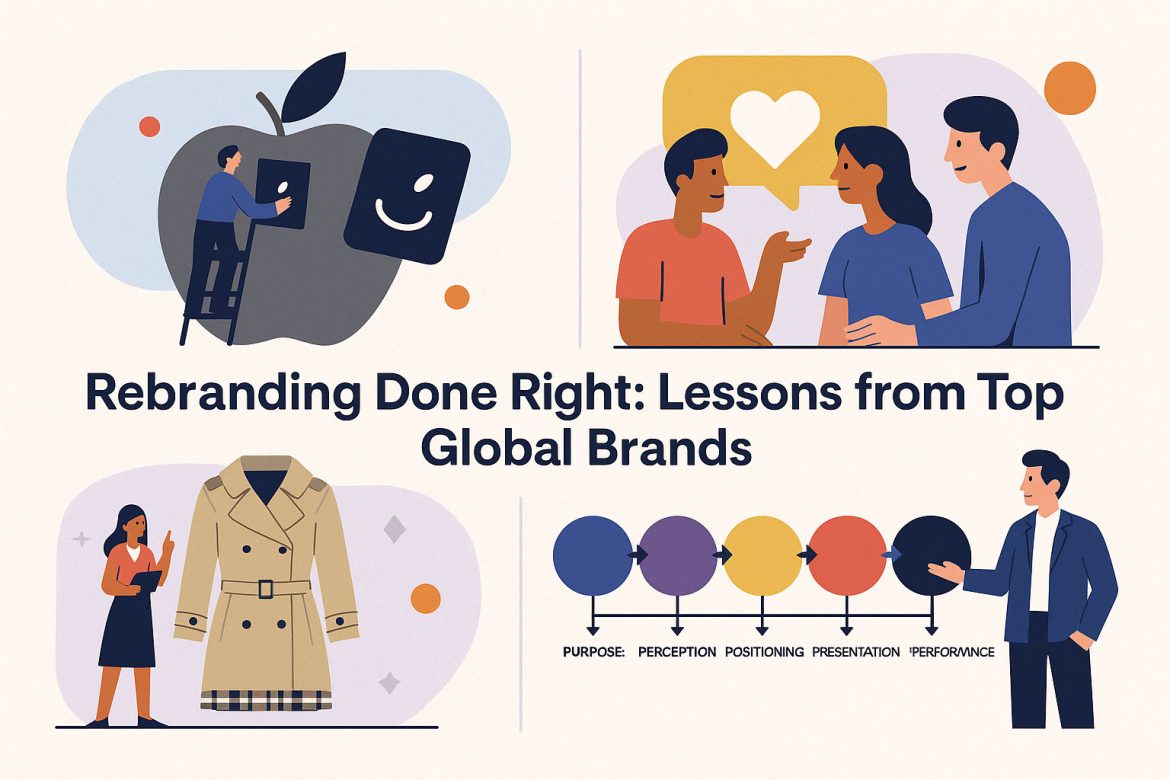Rebranding is often perceived as a cosmetic exercise—new logo, refreshed color palette, updated website. In reality, effective rebranding is a high-stakes transformation that reflects shifts in company vision, market relevance, customer perception, and long-term strategy. When executed with insight and precision, rebranding becomes a tool for redefinition—not reinvention.
This article examines the strategic dimensions of successful rebrands, drawing on real-world examples from top global brands to extract applicable lessons. Rather than focusing on aesthetics alone, we analyze the deeper frameworks that made these brand evolutions impactful and sustainable.
SECTION I: Rebranding Defined — Not Just a New Look
Let’s begin with clarity.
Rebranding is the strategic process of repositioning a company’s identity to align with new goals, audiences, or market realities.
There are three primary types of rebranding:
- Visual Rebrand: New design identity (e.g., Mastercard’s logo simplification).
- Strategic Rebrand: Shift in positioning, values, or mission (e.g., Facebook to Meta).
- Comprehensive Rebrand: Both internal and external transformation (e.g., Dunkin’ dropping “Donuts” to reflect broader product offerings).
In each case, success hinges on internal alignment, audience insight, and market timing.
SECTION II: Case Study Analyses – What Worked, and Why
🟦 1. Apple: From Near Collapse to Iconic Simplicity
Before:
In the 1990s, Apple was perceived as a struggling hardware company with an inconsistent product line.
After:
The return of Steve Jobs brought a complete overhaul—streamlined offerings, minimalist design, and the now-famous monochrome logo.
Key Tactic:
Apple didn’t just change its design. It clarified its philosophy: intuitive, human-centered technology.
Takeaway:
A successful rebrand often begins with subtraction, not addition. Remove what no longer serves your core vision.
🟪 2. Airbnb: From Couch-Surfing to Belonging Anywhere
Before:
A platform for budget travelers and room rentals.
After:
A lifestyle brand centered around local immersion and global belonging, complete with a new symbol: the “Bélo.”
Key Tactic:
Airbnb unified its messaging across platforms, user experience, and community voice.
Takeaway:
Rebranding is most effective when it translates into emotional resonance, not just transactional clarity.
🟨 3. Burberry: From Outdated to Aspirational
Before:
Burberry’s heritage was diluted by overexposure and counterfeit markets.
After:
Under CEO Angela Ahrendts, Burberry reclaimed its luxury positioning through digital innovation and creative direction.
Key Tactic:
The brand honored its history while embracing modern storytelling via live-streamed fashion shows and social campaigns.
Takeaway:
Heritage brands can rebrand successfully by blending legacy with leadership in new cultural contexts.
🟥 4. Dunkin’: Streamlining for Modern Relevance
Before:
Dunkin’ Donuts was tied closely to coffee and donuts—limiting perception.
After:
By dropping “Donuts” from its name, Dunkin’ rebranded as a beverage-first, modern food service brand.
Key Tactic:
The change was supported by store redesigns, mobile ordering enhancements, and product innovation.
Takeaway:
Rebranding should mirror evolving customer behavior—not just internal aspirations.
SECTION III: Rebranding Framework — The 5-Pillar Model
To synthesize these examples, we introduce the 5-Pillar Rebranding Model. This framework guides the planning and execution of any high-impact brand evolution:
| Pillar | Description | Key Question |
|---|---|---|
| Purpose | Clarify the brand’s reason for existing | Why do we need to change? |
| Perception | Assess how the brand is currently viewed | What do customers believe about us now? |
| Positioning | Define your unique space in the market | What do we want to be known for? |
| Presentation | Translate strategy into design and voice | How will we visually and verbally express this shift? |
| Performance | Measure rebranding impact over time | How will we track success and adjust? |
SECTION IV: Common Pitfalls and How to Avoid Them
Rebranding carries risk. Here’s how to mitigate it:
1. Ignoring Stakeholder Input
Include internal teams, loyal customers, and partners early in the process.
2. Misaligning Vision and Execution
Ensure that visuals and messaging reflect actual operational shifts—not just marketing aspirations.
3. Changing Too Much, Too Fast
Incremental evolution builds trust. Sudden pivots without explanation often confuse audiences.
SECTION V: Final Reflections — Beyond the Surface
The strongest rebrands don’t merely change perception—they enhance value. They acknowledge the past, clarify the present, and shape the future. While design plays a role, the true transformation is strategic and cultural.
“A brand is not just what we say. It’s what we believe, how we behave, and how the world experiences us.”
In a market where consumers seek relevance, trust, and authenticity, rebranding done right becomes a catalyst—not a campaign. Use it wisely. Plan it thoroughly. And most importantly—make it mean something.


